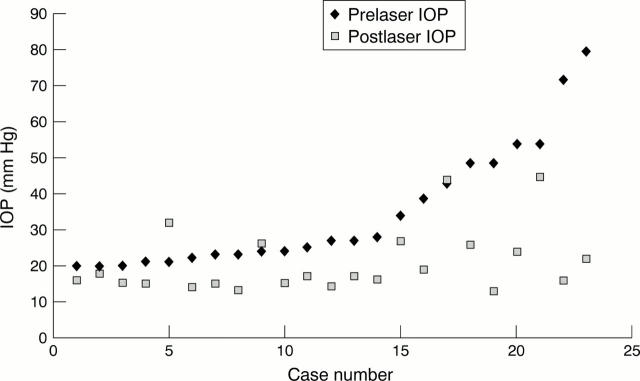Abstract
AIM—To assess the efficacy of Nd:YAG laser iridotomy as initial treatment for primary angle closure in a community setting in rural Mongolia. METHODS—Subjects with occludable drainage angles in two glaucoma prevalence surveys in Mongolia (carried out in 1995 and 1997) were treated with YAG laser iridotomy at the time of diagnosis. These patients were re-examined in 1998. Patency of iridotomy, intraocular pressure (IOP), visual acuity, and gonioscopic findings were recorded. Iridotomy was classified unsuccessful in eyes where further surgical intervention was required or in which there was a loss of visual acuity to <3/60 from glaucomatous optic neuropathy. RESULTS—164 eyes of 98 subjects were examined. Patent peripheral iridotomies were found in 98.1% (157/160) of eyes that had not undergone surgery. Median angle width increased by two Shaffer grades following iridotomy. Iridotomy alone failed in 3% eyes with narrow drainage angles and either peripheral anterior synechiae or raised IOP, but normal optic discs and visual fields. However, in eyes with established glaucomatous optic neuropathy at diagnosis iridotomy failed in 47%. None of the eyes with occludable angles that were normal in all other respects, and underwent iridotomy, developed glaucomatous optic neuropathy or symptomatic angle closure within the follow up period. CONCLUSIONS—Nd: YAG laser iridotomy is effective in widening the drainage angle and reducing elevated IOP in east Asian people with primary angle closure. This suggests that pupil block is a significant mechanism causing closure of the angle in this population. Once glaucomatous optic neuropathy associated with synechial angle closure has occurred, iridotomy alone is less effective at controlling IOP.
Full Text
The Full Text of this article is available as a PDF (138.2 KB).
Figure 1 .
Pre and post iridotomy intraocular pressures (IOP) in eyes with IOP >19 mm Hg before iridotomy (excluding four eyes that underwent glaucoma surgery during follow up interval).
Selected References
These references are in PubMed. This may not be the complete list of references from this article.
- Arkell S. M., Lightman D. A., Sommer A., Taylor H. R., Korshin O. M., Tielsch J. M. The prevalence of glaucoma among Eskimos of northwest Alaska. Arch Ophthalmol. 1987 Apr;105(4):482–485. doi: 10.1001/archopht.1987.01060040052031. [DOI] [PubMed] [Google Scholar]
- Baasanhu J., Johnson G. J., Burendei G., Minassian D. C. Prevalence and causes of blindness and visual impairment in Mongolia: a survey of populations aged 40 years and older. Bull World Health Organ. 1994;72(5):771–776. [PMC free article] [PubMed] [Google Scholar]
- Canning C. R., Capon M. R., Sherrard E. S., Kerr Muir M. G., Pearson R., Cooling R. J. Neodymium: YAG laser iridotomies--short-term comparison with capsulotomies and long-term follow-up. Graefes Arch Clin Exp Ophthalmol. 1988;226(1):49–54. doi: 10.1007/BF02172718. [DOI] [PubMed] [Google Scholar]
- Del Priore L. V., Robin A. L., Pollack I. P. Neodymium: YAG and argon laser iridotomy. Long-term follow-up in a prospective, randomized clinical trial. Ophthalmology. 1988 Sep;95(9):1207–1211. doi: 10.1016/s0161-6420(88)33039-3. [DOI] [PubMed] [Google Scholar]
- Devereux J. G., Foster P. J., Baasanhu J., Uranchimeg D., Lee P. S., Erdenbeleig T., Machin D., Johnson G. J., Alsbirk P. H. Anterior chamber depth measurement as a screening tool for primary angle-closure glaucoma in an East Asian population. Arch Ophthalmol. 2000 Feb;118(2):257–263. doi: 10.1001/archopht.118.2.257. [DOI] [PubMed] [Google Scholar]
- Foster P. J., Baasanhu J., Alsbirk P. H., Munkhbayar D., Uranchimeg D., Johnson G. J. Glaucoma in Mongolia. A population-based survey in Hövsgöl province, northern Mongolia. Arch Ophthalmol. 1996 Oct;114(10):1235–1241. doi: 10.1001/archopht.1996.01100140435011. [DOI] [PubMed] [Google Scholar]
- Gelber E. C., Anderson D. R. Surgical decisions in chronic angle-closure glaucoma. Arch Ophthalmol. 1976 Sep;94(9):1481–1484. doi: 10.1001/archopht.1976.03910040315004. [DOI] [PubMed] [Google Scholar]
- Hung P. T., Chou L. H. Provocation and mechanism of angle-closure glaucoma after iridectomy. Arch Ophthalmol. 1979 Oct;97(10):1862–1864. doi: 10.1001/archopht.1979.01020020310003. [DOI] [PubMed] [Google Scholar]
- Kim Y. Y., Jung H. R. Dilated, miotic-resistant pupil and laser iridotomy in primary angle-closure glaucoma. Ophthalmologica. 1997;211(4):205–208. doi: 10.1159/000310790. [DOI] [PubMed] [Google Scholar]
- Lowe R. F. ACUTE ANGLE-CLOSURE GLAUCOMA: THE SECOND EYE: AN ANALYSIS OF 200 CASES. Br J Ophthalmol. 1962 Nov;46(11):641–650. doi: 10.1136/bjo.46.11.641. [DOI] [PMC free article] [PubMed] [Google Scholar]
- Quigley H. A. Long-term follow-up of laser iridotomy. Ophthalmology. 1981 Mar;88(3):218–224. doi: 10.1016/s0161-6420(81)35038-6. [DOI] [PubMed] [Google Scholar]
- Quigley H. A. Number of people with glaucoma worldwide. Br J Ophthalmol. 1996 May;80(5):389–393. doi: 10.1136/bjo.80.5.389. [DOI] [PMC free article] [PubMed] [Google Scholar]
- Richardson P., Cooper R. L. Laser iridotomy. Aust N Z J Ophthalmol. 1987 May;15(2):119–123. doi: 10.1111/j.1442-9071.1987.tb00056.x. [DOI] [PubMed] [Google Scholar]
- Robin A. L., Arkell S., Gilbert S. M., Goossens A. A., Werner R. P., Korshin O. M. Q-switched neodymium-YAG laser iridotomy. A field trial with a portable laser system. Arch Ophthalmol. 1986 Apr;104(4):526–530. doi: 10.1001/archopht.1986.01050160082017. [DOI] [PubMed] [Google Scholar]
- Sakuma T., Sawada A., Yamamoto T., Kitazawa Y. Appositional angle closure in eyes with narrow angles: an ultrasound biomicroscopic study. J Glaucoma. 1997 Jun;6(3):165–169. [PubMed] [Google Scholar]
- Schwartz L. W., Moster M. R., Spaeth G. L., Wilson R. P., Poryzees E. Neodymium-YAG laser iridectomies in glaucoma associated with closed or occludable angles. Am J Ophthalmol. 1986 Jul 15;102(1):41–44. doi: 10.1016/0002-9394(86)90207-2. [DOI] [PubMed] [Google Scholar]
- Shiose Y. Intraocular pressure: new perspectives. Surv Ophthalmol. 1990 May-Jun;34(6):413–435. doi: 10.1016/0039-6257(90)90122-c. [DOI] [PubMed] [Google Scholar]
- Snow J. T. Value of prophylactic peripheral iridectomy on the second eye in angle-closure glaucoma. Trans Ophthalmol Soc U K. 1977 Apr;97(1):189–191. [PubMed] [Google Scholar]
- Tomey K. F., Traverso C. E., Shammas I. V. Neodymium-YAG laser iridotomy in the treatment and prevention of angle closure glaucoma. A review of 373 eyes. Arch Ophthalmol. 1987 Apr;105(4):476–481. doi: 10.1001/archopht.1987.01060040046029. [DOI] [PubMed] [Google Scholar]
- Yamamoto T., Shirato S., Kitazawa Y. Treatment of primary angle-closure glaucoma by argon laser iridotomy: a long-term follow-up. Jpn J Ophthalmol. 1985;29(1):1–12. [PubMed] [Google Scholar]



